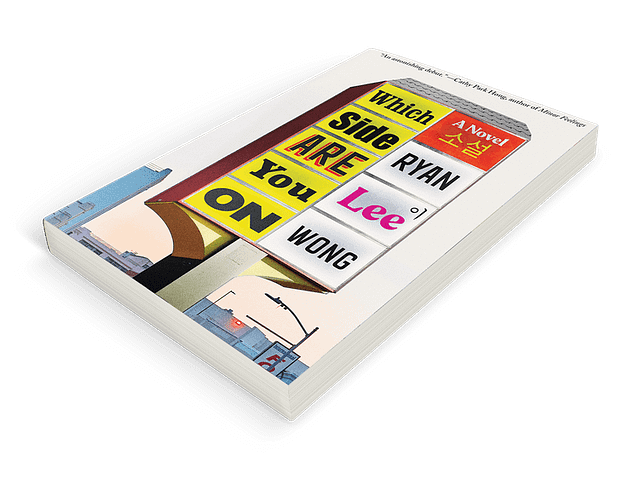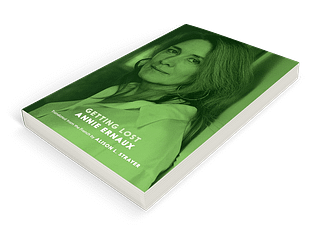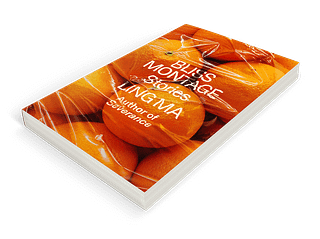Book Review Online
Social Justice Fanfic
On Ryan Lee Wong’s novel Which Side Are You On.
By Kathy Chow

Which Side Are You On
Ryan Lee Wong
Catapult, 192 pp.
What’s up with the novel of ideas? In 2015, Pankaj Mishra and Benjamin Moser speculated in the New York Times Book Review that it had disappeared completely. Seven years later, it seems that novels are bursting at the seams with ideas. Everywhere you turn, contemporary fiction writers are trying to teach you something. But I felt especially patronized by Ryan Lee Wong’s debut, Which Side Are You On. It catapulted me back to middle school, where my teachers tried all sorts of tricks to hold our ever-wandering teenage attention.
The novel follows Reed, a Columbia undergraduate student, over the course of a weekend in LA, where he grew up. His visit takes place in the wake of the killing of Akai Gurley, an unarmed Black man, by a Chinese American NYPD officer. Reed, once an apolitical teenager, gains a political consciousness after he becomes increasingly involved with campus activists. Throughout the weekend, he attempts to extract lessons for the movement from his Korean American mother, who was involved in Korean-Black coalition-building in the nineties. His mother patiently trades pieces of activist history in exchange for spending time with her son.
In the novel of ideas, a class of novel pioneered in the late nineteenth century, the author prioritizes imparting a philosophy, often to the neglect of setting, character development, and plot. The writer can fall back on a limited set of techniques — matter-of-fact dialogue, instructive narration — and Which Side Are You On suffers precisely these constraints. Wong stages a series of conversations between Reed and tropey stand-ins for the dramatis personae in the ever-perplexing tangle of Black-Asian politics: Reed’s mother, of course, in addition to his father (a more genteel embodiment of the wise old activist), Bobby (a Black community organizer who used to work with Reed’s mother), CJ (Reed’s Korean American childhood best friend, whose main function in the novel is to prod at Reed’s self-righteousness), Jane (a childhood acquaintance who personifies Asian American ignorance and dates an explicitly racist white man), and Tiff (an activist at Columbia who feeds many of Reed’s lines about social justice).
Everything is a lesson: Reed’s mother instructs him on the plight of working-class Korean grocers and the threat of violence that plagued community organizing in the nineties. Reed’s Chinese American father, a former labor organizer, explains a community organizing tool called power analysis. Bobby presses the point that community organizing is not about success per se. Reed clumsily regurgitates lines that will feel familiar to anyone who has had even passing contact with contemporary social justice discourse. At a Korean restaurant, for example, he asks, “Isn’t it messed up… how all the waiters are Korean and all the busboys are Latino? That’s a pretty clear example of racial capitalism, except we’re supposed to feel okay because the owners are Korean instead of white.” As the novel progresses, this tendency tips into moments of direct exposition: “It was the first time I glimpsed the truth that was now so clear: the work was not just about overturning the system but about building a space to grieve.” The novel of ideas, as Sianne Ngai points out, is a gimmick. In her succinct formulation, the gimmick is an “overrated [device] that strike[s] us as working too little (labor-saving tricks) but also as working too hard (strained efforts to get our attention).” It is a fitting description of Wong’s novel, in which flat characters offer lectures but also burst into moments of inexplicable action — scenes that I have to guess are not-so-subtle attempts to keep the reader engaged (Reed’s mother, for example, is introduced in the novel as she yells, “Hey, motherfucker!” at a rideshare driver when she picks Reed up from the airport).
Okay, I hear you say. Which Side Are You On is a novel of ideas, and it’s doing what a novel of ideas does. So what? Well, for one, the ideas that Wong peddles in Which Side Are You On are troubling. The conversations in the novel culminate in a rebuke of the naïve self-righteousness exemplified by Reed, who functions as a stand-in for Puritanically idealistic young activists. It’s a loving rebuke, but a rebuke nonetheless. Toward the end of the novel, Reed realizes,
I wanted to create this perfect version of myself. To be this ideal radical. Because if I could do that, then other people could, too, and we could change the world. Now I come here and find out all this pain I’ve inherited from generations, from Halmoni and Haraboji, from the war, the Japanese. Not just our family, but all these Koreans who were abused, then returned that abuse here.
I am onboard with the critique of claims to moral purity, which are almost always suspect. But I worry about this particular deployment of the trauma plot. The trauma plot, per Parul Sehgal, is a narrative rife in contemporary fiction where a storied past is enlisted as an unambiguous explanation for current action. The traumatized individual is often yoked to the traumatized community in turn; as Sehgal puts it, “my trauma becomes but one rung of a ladder. Climb it; what else will you see?” Reed, to his credit, doesn’t harp too much about his own trauma. But he does tap into that of his forebears. His mother was abused by his grandmother, who was in turn abused by his grandfather. As we zoom out, generation after traumatized generation, the suggestion seems to be that everything can be traced back to Japanese colonialism.
The problem with tracing causality back to generational trauma is that it punts the responsibility of accounting for Asian anti-Blackness to an amorphous colonial past. Peter Liang is guilty for killing Akai Gurley; Soon Ja Du is guilty for killing Latasha Harlins. I fear that the trauma plot explanation for Asian anti-Black violence gives up on the notion of personal responsibility as it evacuates Asian Americans of agency. Reed’s musing continues: “Of course they [the Koreans] were neocolonizers extracting resources from South Central, of course they climbed onto their rooftops with guns during Sa-i-gu.” The statement implies an inevitability in the reproduction of violence. But we should resist the suggestion that there is anything inevitable about anti-Black violence.
Maybe this is an uncharitable reading. An accounting of personal responsibility doesn’t have to be mutually exclusive from a recognition of the history of colonial violence. The main concern I have, in any case, is a formal one. The novel of ideas is a form ill-suited to the ends that contemporary Asian American writers wish to wield it for, which I suspect is — to put it bluntly — educating the masses. Wong’s debut hints at a new trend in contemporary Asian American fiction, which I have taken to calling the social justice fanfic. Just as fanfiction reanimates the characters of an extant work, the social justice fanfic animates the usual suspects of Asian American politics to deliver political commentary in an ostensibly entertaining form. We might consider Elaine Hsieh Chou’s Disorientation as another recent example. Disorientation follows Ingrid, a Taiwanese American graduate student, as she confronts Orientalism and navigates debates over free speech on campus. Like Which Side Are You On, Disorientation is a novel of ideas with plenty of things to say about Asian American politics, this time through satire rather than direct dialogue and exposition. A familiar cast populates both novels: there is the humorless Social Justice Warrior Asian, the ignorant conservative Asian, and the cool chill Asian who’s just trying to get by. The racist white man lurks nearby, dating an Asian woman. Black characters are always activists. The novels are narrated by Asian American protagonists coming into political consciousness thanks to their interactions with this cast of flat characters. Collectively, they enact well-worn arguments about race and oppression like an educational puppet show.
Reading these novels feels like being spoon-fed takes that are playing out in real time on social media. In Which Side Are You On, the dialogue is meticulously structured to cover the pros and cons of a gamut of social justice debates. When, for example, the novel raises the question of whether Peter Liang (the Chinese American cop who killed Akai Gurley) should go to prison, Reed’s mother reminds him that “prisons shouldn’t exist,” to which Reed duly replies, “You have to work with the system you have.” I could see this back-and-forth taking place on Twitter. I can also see how Reed’s father’s lecture on power analysis might make a nice infographic on Instagram. I take it that the social justice fanfic is supposed to be something like a syrup that masks the bitter taste of learning about racial politics. But is learning about racial politics so distasteful that we need a syrup? And the truth of the matter is: social justice fanfic riffs on real, not fictional, people, and these real people are all over social media. More to the point, if I wanted to read the takes on social media, I would just get on social media.
It feels especially strange to encounter Twitter-grade politics in a novel, as social media and books function on such drastically different timescales. The novel is a slow form: it takes a long time to write, sell to a publisher, and run through the logistics of publication. On the other hand, social media is a relentlessly efficient. Both Disorientation and Which Side Are You On are about racial politics in the mid 2010s. While many of the injustices they identify persist, our approach to those injustices has changed over the last seven or so years precisely because of the speed enabled by social media. Our contemporary political debates take place rapidly and new consensuses form within the span of days, if not hours. Take abolition for example. Support for prison and police abolition has spread exponentially in the last two years, and it’s jarring to see Reed — supposedly on the cusp of dropping out of college to pursue activism full time — defend prisons. Similarly, at least one review of Disorientation confirmed my impression that Ingrid’s naïveté about racial politics (for example, her discomfort with identifying people as “white”) is oddly anachronistic. In short, the social justice fanfic is doomed to be a genre perpetually behind the times.
How does one justify making art in times of political crisis? This question, though perennial, has resurfaced in an especially pressing way. Social media no doubt exacerbates this pressure to justify oneself by creating a space in which everyone is under constant scrutiny. The emergence of the social justice fanfic reflects an anxiety among writers to make literature “useful.” More insidiously, however, I want to suggest that it reveals something about how the publishing industry conceives of Asian American literature. Is it a coincidence that Chou and Wong are both debut authors? Lauren Michele Jackson and Elaine Castillo have rightly argued that we have a responsibility as readers to not simply read books by nonwhite authors as anti-racist manuals. But the publishing industry, and writers themselves, also need to bring about a future for Asian American literature that doesn’t simply dramatize the most-liked anti-racist tirades on Twitter. Of course Asian American writers can write novels that wield a political message, and political fiction can be good. To argue otherwise would be obviously absurd. This piece opened with a quip about contemporary fiction trying to teach us things, but I cherish novels that pull it off. The problem is that I am not learning anything from social justice fanfic that I can’t absorb from scrolling through Twitter.
Perhaps novelists should attend to what the form of the novel specifically enables. A deep dive into interiority, for example, is a unique strength of the novel, something that other media like theater and film — let alone the endless performance necessitated by social media — cannot depict with the same ease or subtlety. But this possibility is foreclosed in the novel of ideas, at least in its most recent iteration. Nearly every character in Which Side Are You On could be described with a single adjective: self-righteous Reed, ignorant Jane, saucy CJ, wise Dad, moralizing Tiff. And Bobby, the only Black character in the novel, has zero personality. Trust me: I went back to scour the chapter in which Reed has a conversation with him because — while the other adjectives came quickly to me — I could not think of one for Bobby. I return here empty-handed.
It’s a bummer when nonwhite writers cannot write nonwhite subjects as fully fledged people with inner conflicts and desires that are influenced but not determined by race. Those of us who are not perceived as white are already overtasked with serving as mouthpieces for the political beliefs we are presumed to embody (as the Asian on a diversity committee, for example). Why must we conscript our fictional counterparts to that fate as well? I am not calling for Asian American literature to humanize Asian Americans, returning us to the sentimental fiction of the nineteenth century that sought to create nonwhite (typically Black) characters with whom the (presumably middle class, white) reader could identify. What I want is for Asian American writers to write fiction from the premise that Asian Americans (and other people of color) are real, living people, full of complexities and contradictions, and embodying more than one character trait. Ironically, Ryan Lee Wong actually hit the nail on the head in a 2015 interview: “What we’re trying to move towards is a world where the power dynamics don’t limit people, so that we’re not limited by race, we’re not limited by class and gender, but we’re actually able to express our fullest selves within those multiple identities.”
Literary critics have pooh-poohed the American novel for obsessing over personal experience rather than big ideas. But fuck the big ideas. I want Asian American writers to get a little more personal with me. I want quirks and kinks, silly superstitions, petty infidelities. The personal, after all, is political. Duh.


